SHORTENINGS, GROMMETS, AND SELVAGEES
In many cases a rope may prove too long for our use or the free ends may be awkward, or in the way. At such times a knowledge of "shortenings" is valuable. There are quite a variety of these useful knots, nearly all of which are rather handsome and ornamental, in fact a number of them are in constant use aboard ship merely for ornament.

The simplest form of shortening, shown in Fig. 67, is a variation of the common and simple overhand knot already described and illustrated.

These knots are formed by passing the end of a rope twice or more times through the loop of the simple knot and then drawing it tight (Fig. 68). They are known as "Double," "Treble," "Fourfold," or "Sixfold" knots and are used to prevent a rope from passing through a ring or block as well as for shortening.

All gradations from the double to the sixfold are shown in Fig. 69, both in process of making and as they appear when drawn taut.

Another very simple form of shortening is shown in Fig. 70 and is known as the "Single Plait," or "Chain Knot." To make this shortening, make a running loop (A, Fig. 70), then draw a bight of the rope through this loop, as shown at B, draw another bight through this, as at C to D, and continue in this way until the rope is shortened to the desired length; the free end should then be fastened by passing a bit of stick through the last loop, F, or by running the free end through the last loop, as at E.

To undo this shortening, it is only necessary to slip out the free end, or the bit of wood, and pull on the end, when the entire knot will quickly unravel.

The "Twist," or "Double Chain," is made in a similar manner but is commenced In a different way (A, Fig. 71). It may also be made with three separate pieces of line, as shown in B, Fig. 71.

Hold the double loop in the left hand; the part A is then brought over B; with a half turn B is crossed over to A, and then proceed as in the ordinary three-strand plait until the end of loop is reached, when the loose end is fastened by passing through the bight and the completed shortening appears as in Fig. 72.

This same process is often used by Mexicans and Westerners in making bridles, headstalls, etc., of leather. The leather to be used is slit lengthwise from near one end to near the other, as shown in Fig. 73, and the braid is formed as described.

The result appears as in Fig. 74, and in this way the ends of the leather strap remain uncut, and thus much stronger and neater than they would be were three separate strips used.

Another handsome knot for shortening is the more highly ornamental "Open Chain" (Fig. 75). Make the first loop of the rope secure by a twist of the rope and then pass the loose end through the preceding loop, to right and left alternately, until the knot is complete.

The simplest of all shortenings consists of a loop taken in the rope with the bights seized to the standing part (Fig. 76). This is particularly well adapted to heavy rope or where a shortening must be made quickly.

Fig. 77 shows another very simple shortening, which requires no description. This will not withstand a very great strain but is secure from untying by accident and is very useful for taking up spare rope of lashings on bundles or baggage.
"Sheepshanks," or "Dogshanks," are widely used for shortening rope, especially where both ends are fast, as they can be readily made in the centre of a tied rope. There are several forms of these useful knots.

The best and most secure form is shown in Fig. 78. A simple running knot is first made; a bend is pushed through the loop, which is then drawn taut; the other end of the bend is fastened in a similar manner and the shortening is complete.

A much simpler form is shown in Fig. 79, but this can hardly be depended upon unless the ends are seized, as shown in Fig. 80.



Figs. 81-82 illustrate two other forms of shortenings, but these can only be used where the end of the rope is free, and are intended for more permanent fastenings than the ordinary sheepshank; while Fig. 83 is particularly adapted to be cast loose at a moment's notice by jerking out the toggles, A, B.

Grommets are round, endless rings of rope useful in a myriad ways aboard ship as well as ashore. They are often used as handles for chests, for rings with which to play quoits, to lengthen rope, and in many similar ways. The grommet is formed of a single strand of rope five times as long as the circumference of the grommet when complete.
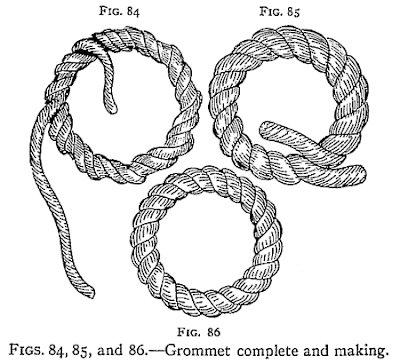
Take the strand and lay one end across the other at the size of loop required and with the long end follow the grooves or "lay" of the strand until back to where you started (Fig. 84), thus forming a two-stranded ring. Then continue twisting the free end between the turns already made until the three-strand ring is complete (Fig. 85). Now finish and secure the ends by making overhand knots, pass the ends underneath the nearest strands and trim ends off close (Fig. 86). If care is taken and you remember to keep a strong twist on the strand while "laying up" the grommet, the finished ring will be as firm and smooth and endless as the original rope.

A "Sevagee" or "Selvagee" strap is another kind of ring (Fig. 87).


This is made by passing a number of strands or yarns around pins or nails set in a board (Fig. 88), and binding the whole together with a seizing of yarn or marline (Fig. 89). These are strong, durable straps much used for blocks aboard ship, for handles to boxes and chests, and in many similar ways.
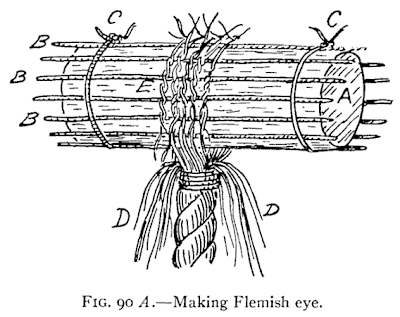
A "Flemish Eye" (Fig. 90) is an eye made in a manner much like that employed in forming the selvagee strap. Take a spar or piece of wood the size of the intended eye A. Around this wood lay a number of pieces of yarn or marline, B, B, B, and fasten them by tying with twine as at C. Whip the piece of rope in which eye is to be formed and unravel and open out the strands as at D. Lap the yarns over the wood and the stops B, and fasten together by overhand knots E, worm the free ends under and over and then bring up the ends of the stops B and tie around the strands of eye as shown.

The eye may be finished neatly by whipping all around with yarn or marline, and will then appear as in Fig. 90 B.
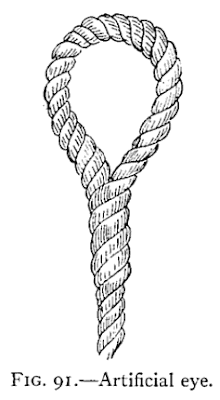
An "Artificial Eye" (Fig. 91) is still another form of eye which will be found useful and in some ways easier and quicker to make than a spliced eye, besides being stronger.
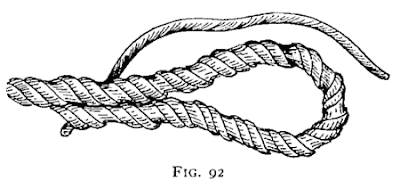
Take the end of a rope and unlay one strand; place the two remaining strands back alongside of the standing part (Fig. 92). Pass the loose strand which has been unlaid over the end, and follow around the spaces between the two strands and then around eye,—as in making a grommet,—until it returns down the standing part and lies under the eye with the strands (Fig. 93). Then divide the strands, taper them down, and whip the whole with yarn or marline (Fig. 94).
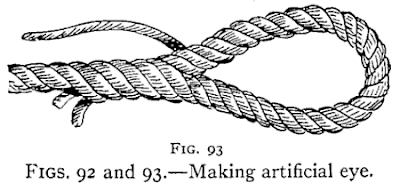


Still another eye which at times will be useful is the "Throat Seizing," shown in Fig. 95. This is made by opening the end slightly and lashing it to the standing part as shown. Another ring sometimes used is illustrated in Fig. 96, and is easily and quickly made by lashing the two ends of a short rope to the standing part of another. Cuckolds' necks with lashings or "Clinches" are also used for the same purpose.
